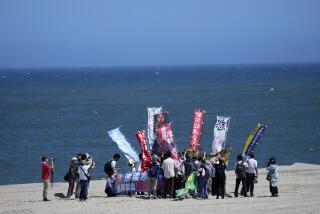Japan’s nuclear workers try to trace leak, dump radioactive water
TOKYO — Workers used a milky bathwater dye Monday as they frantically tried to trace the path of radioactive water seeping into the ocean from Japan’s tsunami-damaged nuclear plant.
The crack in a maintenance pit discovered over the weekend was the latest confirmation that radioactivity continues to spill into the environment. The leak is a symptom of the primary difficulty at the Fukushima Daiichi complex: Radioactive water is pooling around the plant and preventing workers from powering up cooling systems needed to stabilize dangerously vulnerable fuel rods.
The plant operators also deliberately dumped 10,000 tons of tainted water -- measuring about 500 times above the legal limit for radioactivity -- into the ocean Monday to make space at a storage site for water that is even more highly radioactive.
Engineers have turned to a host of improvised and sometimes bizarre methods to tame the nuclear plant after it was crippled in Japan’s magnitude 9.0 quake and tsunami on March 11.
Efforts over the weekend to clog the leak with a special polymer, sawdust and even shredded newspapers failed to halt the flow at a cracked concrete maintenance pit near the shoreline. The water in that leak contains radioactive iodine at rates 10,000 times the legal limit.
Suspecting they might be targeting the wrong channel to the pit, workers tried to confirm the leak’s pathway by dumping several pounds of milky bath salts into the system, plant operator Tokyo Electric Power Co. said Monday.
“There could be other possible passages that the water may be traveling. We must watch carefully and contain it as quickly as possible,” said Hidehiko Nishiyama, a spokesman for the Nuclear Safety and Industrial Agency.
Radioactive water has pooled throughout the plant because the operator has been forced to rely on makeshift ways of pumping water into the reactors -- and allowing it to gush out wherever it can -- to bring down temperatures and pressure in the cores.
Government officials conceded Sunday that it will likely be several months before the cooling systems are completely restored. And even after that happens, there will be years of work ahead to clean up the area around the complex and figure out what to do with it.
The makeshift system makes it difficult to contain the radiation leaks, but it is aimed a preventing fuel rods from going into a full meltdown that would release even more radioactivity into the environment.
“We must keep putting water into the reactors to cool to prevent further fuel damage, even though we know that there is a side effect, which is the leakage,” Nishiyama said. “We want to get rid of the stagnant water and decontaminate the place so that we can return to our primary task to restore the sustainable cooling capacity as quickly as possible.”
To that end, the plant’s operator, Tokyo Electric Power Co., said it jettisoned the 10,000 tons of water Monday, clearing space in a waste-storage facility. The government decided to allow the step as “an unavoidable emergency measure,” Chief Cabinet Secretary Yukio Edano said.
An additional 1,500 tons will be dumped from a trench under the plant’s units 5 and 6. That water is threatening to interfere with the workings at those units, whose reactors are under control.
Radioactivity is quickly diluted in the ocean, and Edano said the dump should not affect the safety of seafood in the area.
The crisis has unfolded as Japan deals with the aftermath of twin natural disasters that decimated large swaths of its northeastern coast. Up to 25,000 people are believed to have died in the disaster, and tens of thousands lost their homes. Thousands more were forced to flee a 12-mile radius around the plant because of the radiation.
The 8-inch-long crack was discovered in the maintenance pit over the weekend. It is sending radioactive water into area that is normally blocked off by a seawall, but a crack was also discovered in that outer barrier Monday.
Though it later authorized the dumping of slightly radioactive water, the government said Monday it was growing concerned about the sheer volume of contaminated materials spilling into the Pacific. It is not clear how much water has leaked from the pit so far.
“Even if they say the contamination will be diluted in the ocean, the longer this continues, the more radioactive particles will be released and the greater the impact on the ocean,” Edano said. “We are strongly urging TEPCO that they have to take immediate action to deal with this.”
The crisis has sparked protests in Japan and raised questions around the world about the safety of nuclear power. The head of the International Atomic Energy Agency told delegates at a nuclear safety conference Monday that the industry cannot afford to ignore these concerns.
“We cannot take a ‘business as usual’ approach,” Yukiya Amano said.
The operator said Monday it is ordering fencing that is typically used to contain oil spills. The screens are not designed to trap radioactivity but might curtail the flow of water and thus reduce the spread of contamination, said TEPCO manager Teruaki Kobayashi. It was not clear when they would arrive.
All of the plant’s reactors were designed by General Electric, and the company’s CEO met Sunday with TEPCO’s chairman. Jeffrey Immelt told reporters Monday that more than 1,000 engineers from GE and its partner Hitachi are helping to analyze the problems at the plant.
Immelt also offered assistance in dealing with the electricity shortage brought on by damage to Dai-ichi and other power plants. Japan is expecting a shortfall of at least 10 million kilowatts come summer.
Gas turbines are on their way from the U.S. with both long- and short-term capabilities, Immelt said.
Japan Internet conglomerate Softbank Corp. said Monday that CEO Masayoshi Son will donate $120 million of his personal wealth plus his salary until he retires to help tsunami victims.
Softbank, the only Japanese mobile carrier offering the iPhone, will also give away mobile phone handsets to tsunami orphans and pay their phone bills until the children turn 18, said company spokeswoman Makiko Ariyama.
Son’s 10 billion yen donation to the Japanese Red Cross Society and other nonprofit organizations is the biggest by an individual to quake and tsunami victims, Ariyama said.
Son, 53, will also donate all of his annual salary each year to aid organizations until he retires.
His salary was 108 million yen ($1.3 million) in the fiscal year through March 2010. Apart from Son’s personal wealth and salary, Softbank said the company will give 1 billion yen to the Japanese Red Cross to support the disaster victims.
More to Read
Sign up for Essential California
The most important California stories and recommendations in your inbox every morning.
You may occasionally receive promotional content from the Los Angeles Times.










